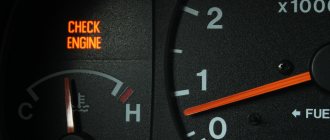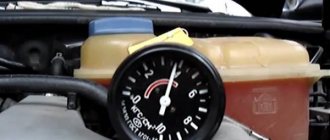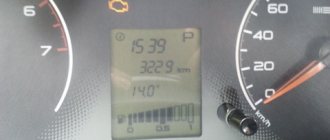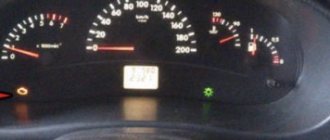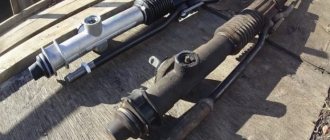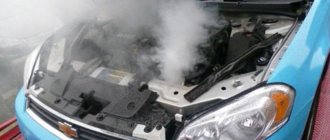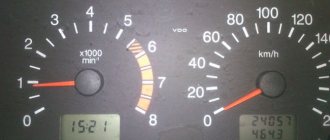Many of us have probably encountered such a problem as turning on the engine icon (“Check engine…”), the appearance of which on the car dashboard scares drivers. Today we invite you to familiarize yourself with the 5 (five) most common reasons why the check engine light comes on on the dashboard.
The appearance of the engine indicator icon on the dashboard usually occurs without warning. The reason for the appearance of this “Check Engine” cannot be immediately understood. Even if the car has auto diagnostics (for example, in cars such as BMW, Audi, Porshe, Mercedes-Benz, VW), which scans all car systems for errors and their presence, displaying decryption information on the instrument panel, such reasons for the appearance The engine checks will not be deciphered.
For most drivers, the appearance of this warning icon on the instrument panel means the need to urgently go to a car repair shop for diagnosis and to eliminate the reason why the “Check Engine” warning icon appeared. But in fact, in most cases, when the “Check” indication appears, you can independently diagnose the cause of the engine failure, and in some cases it is even possible to eliminate this cause yourself without a trip to a car service center, which will certainly save you money.
Replace the oxygen sensor (lambda probe)
The oxygen sensor in your car is part of the exhaust system that monitors how much oxygen is not burned in the engine combustion chamber. This sensor helps control the vehicle's fuel consumption. A malfunction of the oxygen sensor (lambda probe) means that the car computer does not receive the correct data and can significantly increase fuel consumption, and at the same time reduce engine power. Most cars have 2 to 4 oxygen sensors. If you have a home car error scanner, then by connecting it to the car you can easily find out which sensor needs to be replaced.
For what reason does the oxygen sensor in a car become unusable: - Over time, the sensor becomes covered with a layer of used and regular motor oil (oil soot), which reduces the accuracy of reading sensor readings for regulating the gasoline mixture and distributing optimal fuel consumption. A malfunction of the oxygen sensor in a car leads not only to increased fuel consumption, but also to an increased content of harmful CO2 substances in the exhaust.
What needs to be done: -If you do not change a faulty car oxygen sensor, this may lead to failure of the car catalyst (it may burst), which will result in expensive repairs for you. The cost of new catalysts is very high due to the precious alloys they contain. Some cars have several of these catalysts at once and their cost can reach up to 90 thousand rubles. So gentlemen, don’t delay replacing the oxygen sensor. Although replacing the sensor itself and its cost are decent, it is still not commensurate with the cost of the exhaust gas catalyst system itself. You can save money on replacing this sensor by doing it yourself. Many car manuals have detailed instructions on how to replace the oxygen sensor yourself. If you know where the oxygen sensor is located, then it will not be difficult for you to disconnect the faulty lambda probe and replace it with a new one. Remember that you cannot delay replacing this important element!
How to check engine errors and erase the error in the computer memory
To carry out engine diagnostics and read error codes, as well as to reset them, many drivers prefer to go to a service station where there is a scanner. Service station specialists, at the owner’s request, can issue a printout that will display the error codes recorded in the memory of the control unit.
In such a situation, you can buy a scanner for personal use, but its cost and the need to study the features of the software make this method impractical, especially when it comes to diagnosing only one car. Let us add that the scanner is used in parallel with a laptop or personal computer, which creates additional inconvenience.
All kinds of third-party BCs (on-board computers) also rightly belong to similar ones in terms of ease of use, cost and feasibility of purchase. The solution is capable of reading and deciphering error codes and displaying additional information about the parameters and operating modes of the internal combustion engine. At the same time, the BCs require proper connection and separate installation in the cabin.
Among the main advantages of such adapters is that the device is a small, compact “box” that is inserted into the diagnostic socket of your car. This means that the need to connect, lay wires, place the device itself in the cabin, use a PC and perform other additional actions is completely absent.
The adapter in the connector remains almost invisible and connects to a tablet or smartphone “over the air” thanks to bluetooth/wi-fi technology. This is especially convenient when the engine error lights up periodically. In other words, you can drive with the adapter in the connector as long as you like, and at the moment the check light comes on, immediately read the fault code.
As for the software, it may be supplied with the adapter. The necessary programs are also available in the Play Market for Android and similar solutions for devices on other operating systems. The software must be installed on a smartphone/tablet. Note that among the various available solutions, the Torque program is very popular (a free version of this application is available in the Market for Android).
Using the solution looks like this:
- The adapter is inserted into the vehicle's diagnostic connector;
- A smartphone/tablet with installed software is installed in the holder;
- Next, the car starts;
- Bluetooth is turned on on your smartphone or tablet;
- A program (for example, Torque) is launched on the phone/tablet;
Now you need to wait for the adapter and device to synchronize with the program, after which the parameters of the operating power unit are displayed. To determine why the check is on, you need to go to the appropriate subsection on your mobile device.
Check the fuel filler cap
Many drivers, in some cases, when the “check engine” indication appears, begin to think about serious problems with the engine; they do not even think of checking the tightness of the fuel system, which may be compromised due to a defect or an insufficiently tightened fuel tank cap. This is a very common reason for the appearance of the “Check” engine icon.
Reason for the error: - Leakage of the fuel system due to the passage of air through the filler cap of the fuel tank, as well as an increase in the fuel consumption of the vehicle, for which the vehicle’s diagnostic system will definitely display an engine error by turning on the “Check engine” indication on the vehicle’s instrument panel.
What needs to be done: -If when the “Check” indication appears, your car has not lost its power and there are no audible signs of engine damage (knocking, humming, creaking, etc. in the engine), then the first thing you need to do is check the gas tank for leaks. Your gas cap may be cracked or not tightened enough. If the gas tank cap was not tightened enough, then after tightening it all the way, you can continue driving the car for a while, and then look at the dashboard and see if the engine error disappears. To prevent the check engine light from appearing and lighting up, check the fuel filler cap regularly. Remember also that periodically this cover must be replaced with a new one!
The injector icon is on: what is the reason?
For many car enthusiasts, while driving, their mood is spoiled by the constantly burning or flashing Check Engine injector light. And there seem to be no obvious reasons for this. Even experienced car service technicians will not be able to give an answer to this right away. Let's try to understand in more detail the very structure of the mentioned reason.
The principle of operation is as follows: the vehicle's electronic control unit (ECU) controls its engine through sensors in the Powertrain system. When the injector light comes on, this means that one or more sensors indicate a change in parameters in a critical direction. Now let's look at some of the functions that are assigned to sensors, which will help you determine the nature of the violations.
Car exhaust catalyst
An automobile catalytic converter helps the vehicle make this engine exhaust more environmentally friendly. It converts carbon monoxide and other harmful substances into harmless compounds. If your exhaust catalyst has become unusable, then you will notice it not only when the check engine icon appears, but also long before the moment when the power of your car drops by half. For example, when you press the gas pedal, your car will not have the same good acceleration dynamics as before.
What can cause a car catalyst to fail: -If you regularly service your car in accordance with the car company's maintenance regulations, then the catalyst in the car should not fail. The main reason for catalyst failure is untimely replacement of a faulty oxygen sensor, as well as irregular replacement of spark plugs after their expiration date. When the oxygen sensor or spark plugs are faulty, the conversion of carbon monoxide in the catalyst into harmless chemical elements stops, and this leads to overheating of the catalyst, which because of this can fail.
What needs to be done: -If your catalyst has become unusable, then you cannot drive a car, since the engine in the car will not work correctly, warning about this by an indication on the dashboard with the “check” engine icon. Also, your car's fuel consumption will greatly increase and there will be no engine traction. Although replacing the catalyst is an expensive repair, there is still no escape from this repair. Although today there is an alternative to replacing the catalyst with a flame arrester, this is not a 100% option. Unfortunately for many, if you are not an experienced auto mechanic, you will not be able to replace a faulty exhaust gas catalyst yourself. In any case, you will have to contact a car repair shop. Remember, friends, that timely replacement of oxygen sensors and spark plugs protects your catalyst from damage!
The check light on the VAZ 21099 injector causes
Hi all.
A couple of hours ago such a problem appeared; while driving, the car jerked violently several times. There were literally three good jerks, after which the check light on the dashboard came on. Now after starting the engine, after about a minute the check light comes on, although the car does not jerk when accelerating. There are no symptoms at all, the traction is the same, the speed does not fluctuate. 2109 injection It is necessary to carry out diagnostics with a scanner, read errors and carry out checks on them. There is probably a bad connection on one of the engine sensors. You can, for example, remove the battery terminal for 5 minutes, if the Check light comes on again, then go for diagnostics, but while the Check light is on, it is better to immediately go for diagnostics, so that you know what error there is, so that it can be eliminated, so that it does not appear in the future.
Look in the fuse box under the passenger side shelf. There are 3 relays and 3 fuses. Check their tightness (contact may be loose)
An acquaintance complained about the same jerking, they found a loose fuel pump fuse (it either blew or didn’t).
Subscribe
to our channel in
Index.Zen
Even more useful tips in a convenient format
What is a check? Why can it catch fire, and what is it? We will tell you for young people who are not competent in the structure of a car, its electronics, ignition system, etc. Let's look at the check injector and why it lights up. There are several reasons and ways to eliminate them.
Replace the mass air flow sensor
The mass air flow sensor regulates the amount of air that must be added to the gasoline mixture for optimal combustion of the fuel. This sensor constantly reports data on the amount of oxygen supplied to the car's computer. A faulty mass air flow sensor increases this fuel consumption and also increases the level of CO2 in the exhaust gas, thereby reducing engine power and smoothness. Also, if the sensor is faulty, poor acceleration dynamics are observed. In cold weather, a car with a faulty sensor has difficulty starting.
What are the reasons for the failure of the mass air flow sensor: -Most failures of such sensors occur due to improper installation of the air filter during its scheduled replacement. Also, if you do not regularly change the air filter, as required by the vehicle maintenance regulations recommended by the automaker, the mass air flow sensor may fail.
What needs to be done: -Theoretically, you can, of course, drive for a long time with a broken mass air flow sensor (several weeks or months). But you yourself will soon notice that the longer you drive, the more fuel consumption increases. Replacing a sensor in a car service is not so expensive, since this work itself does not take much time and is quite simple. Its main expenses are related to the cost of the sensor itself, which for some car models can cost from 11,000 to 14,000 thousand rubles if it is an original sensor, or up to 6,000 thousand rubles if it is an analog substitute. Replacing the sensor yourself is very simple. But, due to the low cost of the work itself to replace the sensor, you can entrust this work to an ordinary auto mechanic at a car service center. Remember, friends, that it is necessary to regularly change the air filter, observing the established maintenance regulations for the car!
Throttle Position Sensor
The sensor is responsible for the entire process of engine operation in acceleration, driving at a uniform speed and deceleration. The sensor is responsible for monitoring several engine modes, so it is extremely sensitive to the effects of electromagnetic fields and requires constant preventive maintenance, which can be carried out independently.
The sensor is usually located on the side of the engine and consists of two sensors, which are interconnected with the driver’s gas pedal through the computer. If the sensor is adjusted normally and the Check Engine lights up due to this reason, then it signals the owner about engine malfunctions. Indirect reasons may be: decreased power, increased fuel consumption, on cars with automatic transmission – characteristic “jerking” when switching gears, uncertain engine starting, “dips” during acceleration, increased idle speed. Ignoring this can result in serious engine damage, so you should immediately contact a car service center.
